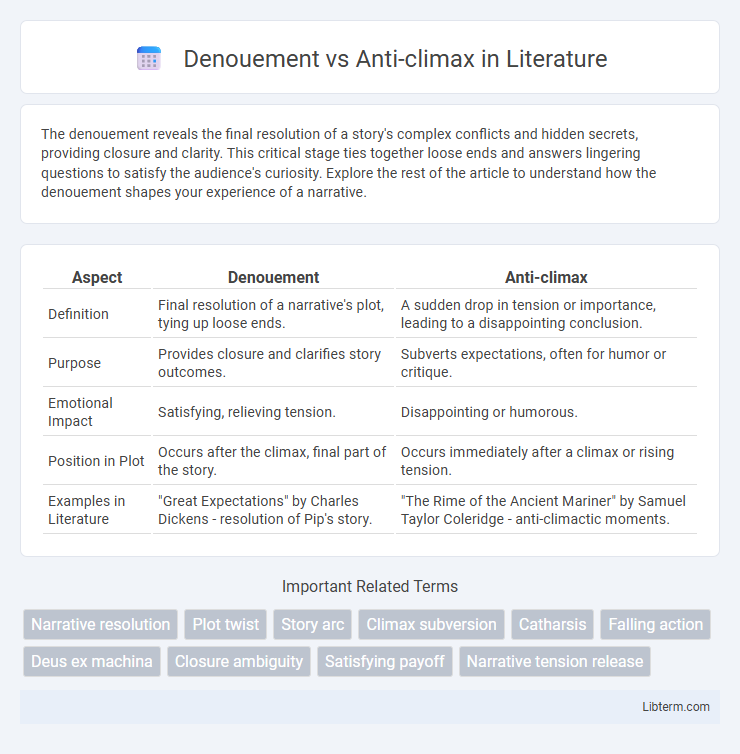The denouement reveals the final resolution of a story's complex conflicts and hidden secrets, providing closure and clarity. This critical stage ties together loose ends and answers lingering questions to satisfy the audience's curiosity. Explore the rest of the article to understand how the denouement shapes your experience of a narrative.
Table of Comparison
| Aspect | Denouement | Anti-climax |
|---|---|---|
| Definition | Final resolution of a narrative's plot, tying up loose ends. | A sudden drop in tension or importance, leading to a disappointing conclusion. |
| Purpose | Provides closure and clarifies story outcomes. | Subverts expectations, often for humor or critique. |
| Emotional Impact | Satisfying, relieving tension. | Disappointing or humorous. |
| Position in Plot | Occurs after the climax, final part of the story. | Occurs immediately after a climax or rising tension. |
| Examples in Literature | "Great Expectations" by Charles Dickens - resolution of Pip's story. | "The Rime of the Ancient Mariner" by Samuel Taylor Coleridge - anti-climactic moments. |
Understanding Denouement: Definition and Purpose
Denouement is the final part of a narrative where conflicts are resolved and loose ends are tied up, providing clarity and closure to the story. Its primary purpose is to reveal the consequences of the climax and restore a sense of order, allowing the audience to understand the outcome of the plot's events. Unlike an anti-climax, which involves an unexpected or disappointing resolution, the denouement delivers a satisfying and meaningful conclusion aligned with the story's development.
What is an Anti-Climax? Key Characteristics
An anti-climax occurs when a narrative builds up tension or expectation but concludes with a disappointing or trivial outcome, subverting audience expectations. Key characteristics include a significant drop in emotional intensity, an unexpected or underwhelming resolution, and often a shift from dramatic to mundane or humorous tone. This device can emphasize irony, critique grandiose setups, or intentionally deflate narrative suspense to create a unique storytelling effect.
Denouement vs Anti-Climax: Core Differences
Denouement and anti-climax serve distinct roles in storytelling, with denouement resolving plot threads and providing closure, while anti-climax results in an unexpectedly disappointing or subdued ending. Denouement typically follows the climax, offering a clear and satisfying resolution that ties up conflicts and character arcs. In contrast, anti-climax subverts audience expectations by delivering an outcome that lacks the anticipated intensity or significance, often creating a sense of anticlimax or deflation.
Impact on Storytelling: Emotional Resonance
Denouement provides emotional resonance by offering closure, resolving conflicts, and satisfying the audience's expectations, which enhances the story's overall impact through a sense of completeness. Anti-climax disrupts this by delivering an unexpected or underwhelming resolution, provoking surprise or disappointment that challenges traditional narrative satisfaction. Both techniques influence storytelling by shaping audience emotions, either reinforcing attachment to characters and plot or creating a critical reflection on narrative conventions.
Classic Examples of Denouement in Literature
Classic examples of denouement in literature include the resolution of the mystery in Arthur Conan Doyle's *The Hound of the Baskervilles* and the reconciliation of conflicts in Jane Austen's *Pride and Prejudice*. Denouement signifies the final unraveling and clarification of the plot, whereas an anti-climax delivers an unexpected, often disappointing resolution that subverts reader expectations. The denouement brings closure and understanding, essential for narrative completeness and thematic resolution.
Notable Instances of Anti-Climax in Narratives
Notable instances of anti-climax in narratives include the ending of Franz Kafka's "The Metamorphosis," where Gregor Samsa's sudden death abruptly halts the story's tension without clear resolution, subverting traditional expectations of closure. In Joseph Heller's "Catch-22," the anti-climactic conclusion reflects the absurdity and chaos of war, emphasizing irony over resolution. These endings challenge conventional denouement by leaving readers in a state of ambiguity or dissatisfaction, highlighting thematic elements through unresolved or anticlimactic conclusions.
Writer’s Intent: When to Use Each Device
Writers employ denouement to provide clear resolution and closure, tying up narrative threads to satisfy readers with a coherent conclusion. Anti-climax is strategically used to subvert expectations, creating surprise or humor by leading the audience toward a significant event before delivering an understated or trivial outcome. Choosing between denouement and anti-climax depends on the desired emotional impact and thematic emphasis within the story's structure.
Reader Expectations and Narrative Payoff
The denouement resolves the story's central conflicts, providing readers with satisfying closure and fulfilling narrative payoff aligned with established expectations. In contrast, an anti-climax subverts these expectations by delivering an unexpected or underwhelming conclusion, often creating surprise or disappointment. Reader expectations hinge on narrative buildup, making the denouement crucial for emotional resolution, whereas the anti-climax challenges traditional payoff structures.
Common Mistakes in Crafting Endings
Writers often confuse denouement with anti-climax, mistakenly treating both as simple story endings but they serve distinct purposes; denouement resolves plot threads and provides closure, while an anti-climax delivers a disappointing or deflating conclusion contrary to audience expectations. A common mistake is rushing the denouement, resulting in unresolved conflicts and weakening the story's impact. Overusing anti-climaxes can frustrate readers, leaving them unsatisfied and diminishing narrative tension built throughout the plot.
Tips for Balancing Suspense and Satisfaction
Effectively balancing suspense and satisfaction between denouement and anti-climax involves carefully managing the release of tension to maintain reader engagement. Writers should ensure the denouement resolves key conflicts and answers critical questions without dragging, while an anti-climax may intentionally subvert expectations to provoke thought or humor. Employing pacing techniques and strategically placing plot revelations allows for a satisfying conclusion that aligns with the story's tone and thematic goals.
Denouement Infographic

 libterm.com
libterm.com